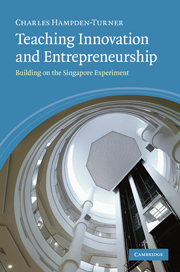Book contents
- Frontmatter
- Contents
- List of grids
- List of dilemmas
- Acknowledgements
- Introduction
- 1 Singapore’s challenge
- 2 The entrepreneurial ecosystem
- 3 How can innovative pedagogies be measured?
- 4 Co-defining innovative education
- 5 The Singapore results
- 6 Results of the Mandarin-speaking programme
- 7 Reconciling values
- 8 ‘It is only the Hawthorne Effect’
- 9 The programme that cannot stand still
- 10 Innovation and the future of the university
- 11 What are the implications of being able to teach innovation?
- 12 Is a new creative class arising?
- Notes
- Bibliography
- Appendices
- General index
- Index of dilemmas and reconciliations
Introduction
a headlong assault on the inexpressible?
Published online by Cambridge University Press: 05 July 2014
- Frontmatter
- Contents
- List of grids
- List of dilemmas
- Acknowledgements
- Introduction
- 1 Singapore’s challenge
- 2 The entrepreneurial ecosystem
- 3 How can innovative pedagogies be measured?
- 4 Co-defining innovative education
- 5 The Singapore results
- 6 Results of the Mandarin-speaking programme
- 7 Reconciling values
- 8 ‘It is only the Hawthorne Effect’
- 9 The programme that cannot stand still
- 10 Innovation and the future of the university
- 11 What are the implications of being able to teach innovation?
- 12 Is a new creative class arising?
- Notes
- Bibliography
- Appendices
- General index
- Index of dilemmas and reconciliations
Summary
‘Headlong assaults upon the inexpressible are not guaranteed to succeed’, a wise mentor once warned me. Innovation and entrepreneurship are indeed indefinable. They cannot be defined in the sense of ‘put limits to’. They break out, again and again. Innovation is a language and like languages in general can generate endless new combinations. In these pages I shall try to show how.
There are many reasons to be sceptical about the practicalities of teaching innovation. If such lessons are ‘innovative’ in themselves, then students who absorb this are being compliant, not original. Would not genuinely innovative students find fault with their lessons and rebel? Why would innovative teachers bother to instruct others, when by taking their own advice they could be enterprising, rich and famous? If we define innovation as making new combinations of existing knowledge, then is not the role of the university to impart that existing knowledge? How else are new combinations to be formed? An innovative physicist needs to know his physics. Teaching innovation to young people could be an invitation to cut corners and avoid accumulating facts.
There are also major difficulties about how innovative work is to be graded and assessed. How do you grade someone who has surprised, even confounded you? How is the merit of innovators to be gauged when the very definition of ‘merit’ has been changed by their contributions? Students who seek to enlighten their teachers might not get the recognition they deserve. It is a rare teacher who invites his authority to be undermined.
- Type
- Chapter
- Information
- Teaching Innovation and EntrepreneurshipBuilding on the Singapore Experiment, pp. 1 - 6Publisher: Cambridge University PressPrint publication year: 2009



